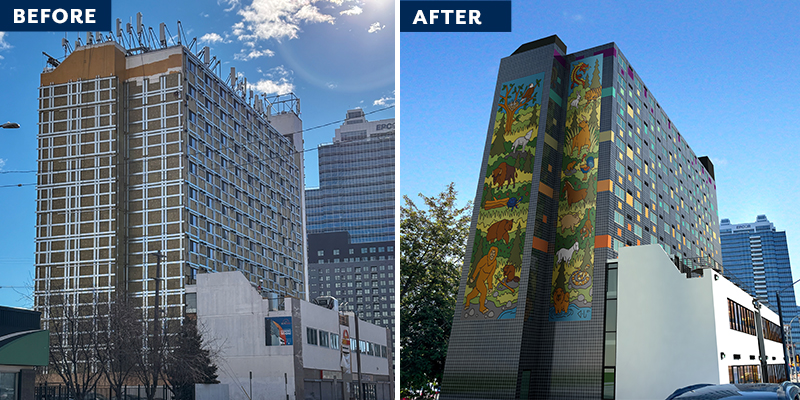Where Sustainability Meets Asset Performance
The Canadian housing market has become increasingly characterized by structural supply shortages and affordability challenges. While new construction is at the forefront of the discussion, there is a compelling case for revitalizing Canada’s existing multi-family dwellings. Compared to building new, retrofits offer a practical and timely solution, breathing new life into long-standing neighbourhoods while reducing environmental impact. There is merit for multi-family property owners to continue exploring the transformative power of large-scale retrofits in addressing the housing crisis, fostering a more sustainable future, and creating value for investors.
Extending the life of older properties
Many of today’s investors are looking for opportunities with purpose. They consider a company’s social and environmental impact before investing, seeking both return performance and sustainable, ethical options that align with their values. Forward-thinking investment funds offer this cohort of investors an investment option that balances these desires.
Investing in older properties and extending their useful life is an efficient and affordable way to create modern spaces with a reduced carbon footprint in desirable communities. The UN’s Global Status Report finds that “the buildings and construction sector contributes significantly to global climate change, accounting for about 21 per cent of global greenhouse gas emissions. In 2022, buildings were responsible for 34 per cent of global energy demand.” Other sources have found that retrofitting an existing building emits 50 to 75 per cent less carbon than constructing the same building new. Unlike new developments, where significant building resources and environmental disruption are required to create supporting infrastructure, shifting the focus to the sustainable retrofitting of existing buildings offers a more eco-conscious approach.
According to data compiled by the Canada Mortgage and Housing Corporation (CMHC), over 80 per cent of Canada’s rental buildings were built before the year 2000. With an aging housing stock, maintaining and upgrading these properties is the quickest path to addressing our nation’s housing crisis. Older buildings can be upgraded relatively quickly to improve energy efficiency and modernize living spaces while utilizing established infrastructure and minimizing external disruption. This strategy increases the long-term value of existing properties and aligns with investor priorities.
A collaborative approach
While there are benefits to transforming aging properties into modern, sustainable homes, bringing these large-scale retrofits to life requires innovation and collaboration between public and private entities. There is an opportunity for property owners to work closely with financial institutions and various levels of government, specifically where programs are offered that incentivize green building projects. Property owners capitalizing on the potential of this solution have been able to showcase how strategic investment in older buildings can deliver robust financial performance for investors, especially when partnering with government and exploring funding options.
Avenue Living has recently proven the benefits of this type of solution by successfully using programs offered by the Canada Infrastructure Bank (CIB) and Bank of Montreal (BMO) to access financing structures supporting energy-efficiency initiatives. These types of financing offerings can help to move ambitious, large-scale retrofitting projects through to completion. By securing favourable lending terms, property owners can implement sustainable renovations while maintaining market-competitive rental prices, without compromising investor returns.
Case Study: The SunRise property in Edmonton, Alberta
The transformation of The SunRise property in Edmonton is a recent example of how a housing provider can revitalize aging housing stock. Formerly known as Capital Tower, this 12-story, 179-unit building constructed in 1970 is situated in a prime location but was being underutilized in the local rental market because it needed extensive renovations. Rather than demolishing and rebuilding, Avenue Living gave the building new life through environmentally sustainable upgrades.

Significant renovations were undertaken with the goal of reducing the building’s carbon footprint while also showcasing the neighbourhood’s cultural heritage with a unique solar panel mural designed by local Indigenous artist Lance Cardinal. The solar panels generate energy used by the common areas of the building while doubling as a striking art installation. At 26 meters high, it is North America’s largest vertical solar panel art array.
Beneath the solar façade, new insulation on the building’s exterior walls improved the efficiency of the interior. Coupled with new triple-glazed windows, these measures help keep residents comfortable year-round and allow the heating and cooling systems to run more efficiently. The inside of the building was also extensively renovated, with in-suite updates to modernize the interior, improve heating, cooling and ventilation, and reduce overall greenhouse gas emissions.
Financing for the improvements at The SunRise was obtained through BMO’s offerings available for energy-efficiency initiatives.
By prioritizing sustainability, affordability, and community engagement, Avenue Living continues to build a portfolio that aligns with the values of today’s investors. This proven model seeks strong financial returns alongside long-term social and environmental benefits. Through strategic partnerships, innovative property revitalization, and a commitment to ESG principles, Avenue Living is paving the way for a more sustainable future — one building at a time.
RIA Disclaimer
The views and opinions expressed in this article are solely those of the authors and do not necessarily reflect the view or position of the Responsible Investment Association (RIA). The RIA does not endorse, recommend, or guarantee any of the claims made by the authors. This article is intended as general information and not investment advice. We recommend consulting with a qualified advisor or investment professional prior to making any investment or investment-related decision.

